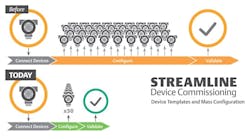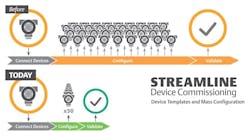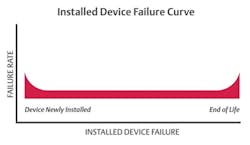Manufacturing organizations often view tools and technologies for ensuring field process instrumentation reliability only as a vehicle for delivering operational benefits – in other words, something the operations team can be responsible for after a project is completed. As a result, the focus with project implementation has long been on delivering short-term results for capital project execution while leaving reliability teams to figure out how and where they can implement reliability features long after the project execution team has moved on.
New developments in project execution, though, are revolutionizing this old model. Instead of waiting until after project execution is complete to implement reliability strategies, many project teams are working with reliability champions to develop new programs that include reliability technologies in the project scope. These new developments in project design are enabling teams to execute projects faster and more successfully while simultaneously building a foundation for a reliability program that is online from the moment the plant begins operation.
Selling the project execution benefits of reliability
When operations teams – specifically reliability and maintenance personnel – help project teams understand the ways in which reliability technology can improve project execution, everyone wins. Project teams win by delivering faster, less-expensive, and more-successful implementations, while operations and reliability teams reap the benefits of having their own systems online and ready to go as soon as a new project is completed. Operations and reliability leaders who communicate and implement solutions beneficial to project implementation success and to long-term reliability can become project influencers, driving future decisions that incorporate operational certainty into project certainty.
At the heart of this new project delivery model are three key strategies that move the focus on reliability from project completion to project scope, paying significant dividends in fewer project delays and lower overall project costs.
Strategy 1: Using reliability to speed commissioning
With only a handful of technicians responsible for hundreds or thousands of devices in the field, reliability teams have needed to develop strategies to increase efficiency. Key reliability technologies have allowed the maintenance team to centralize monitoring and configuration of devices to perform their tasks with more speed and accuracy.
Because the commissioning process for capital projects often is plagued by inefficiency, commissioning is an ideal area for collaboration between reliability and project teams. Configuration of devices during commissioning is slow and cumbersome, with multiple technicians traveling back and forth between devices to check accuracy and functionality. Moreover, configuration typically is performed only after devices have been delivered and installed. Any errors here can have a significant negative impact on start-up, resulting in thousands or millions of dollars of lost revenue.
Project teams can use reliability technologies to significantly speed commissioning. By replacing manual configuration with bulk configuration of field devices via templates, teams can save at least one hour of work per device. This can mean thousands of hours saved in the field (see Figure 1).
Moreover, incorporating reliability technology into project scope takes configuration off the critical path, diluting it across the early months of the project, as configuration will no longer require devices to be on site and installed. Configuration specialists can be contacted months in advance to create templates in preparation for device installation. Saved work hours can be used on other critical commissioning and start-up tasks.
Incorporating reliability tools to realize commissioning benefits will enable project teams to regain control over timelines, ensuring that configuration needs don’t delay start-up. In return, reliability teams gain the advantage of having their tools in place, accompanied by an accurate asset database, from the first day of operation.
Strategy 2: Using reliability tools to use labor more efficiently
Reliability teams cannot afford redundant work in the field. Time spent traveling back and forth to devices and repeating the same tasks is time wasted. To prevent technicians from revisiting the same devices over and over, reliability technologies allow maintenance personnel to perform multiple tests with multiple steps using automated processes from a centralized location.
Rework is all too common during large capital projects. After visiting each device to ensure mechanical completion, technicians need to perform device testing, which often requires that technicians revisit equipment to ensure loop and interlock functionality.
Forward-thinking project teams are incorporating reliability tools into project scope to reduce or eliminate this redundant work during project implementation. For example, reliability teams frequently use automated loop checking and interlock testing to replace the old method of testing: connecting a handheld device to each unit in the field. Using reliability technologies lets technicians perform testing from the convenience of the control room or the maintenance shop with test steps managed and checked for accuracy by the asset management system. Redundant trips to the field are eliminated.
Another area where reliability time-savers can translate directly to project execution savings is in generating documentation. The reliability team understands that the last thing a technician needs to be doing is trying to balance a laptop along with a handheld and a clipboard, attempting to document 200–300 device configuration parameters. When those 200–300 parameters are multiplied by thousands of devices, as they are in most capital projects, the cost and hassle of manual documentation of device and activity data can quickly spiral out of control.
Through collaboration with the project team to perform essential tasks such as device configuration, loop checks, and testing through the plant’s asset management software, though, all activity can be automatically recorded and standardized in the database using the software’s audit trail feature.
Project teams that leverage common reliability tools such as automated loop and interlock testing see a competitive advantage. Using these tools during project execution can eliminate unnecessary field time for technicians by enabling more accurate testing the first time. In addition, implementing reliability tools early will help project teams deliver better records, more data, and increased efficiency, helping operations and maintenance improve processes from day one.
Strategy 3: Using reliability to reduce device infant mortality
Reliability personnel know that the more they interfere with a device, the more likely it is to fail. For this reason, reliability technologies are designed to test and monitor equipment with little to no physical intervention. Devices are most likely to fail at the beginning of their lifespan, with failure rate decreasing significantly after the handoff to maintenance (Figure 2).
High device infant mortality rate has a significant impact on capital project success. Device failures map directly to increased costs and project delays as teams are forced to quickly replace failed devices, often with an added charge for expedited delivery. Project teams can reduce cost and preserve project timelines by finding a way to reduce the failure rate present at the beginning of the failure curve.
The reason for this high infant mortality rate in devices is well known by project teams taking advantage of reliability strategies. Each time a technician interferes with a device by connecting and disconnecting a monitor, turning the device on and off, or assembling and disassembling the unit, the likelihood of failure in the device increases. When are these invasive operations performed most frequently? During testing. The reason for the significant drop in failure rates after the handoff to maintenance is that maintenance is well-trained in using noninvasive methods to monitor and test plant devices.
Innovative project teams use the same technologies the reliability team uses for noninvasive testing and configuration of their field devices. Including these technologies in the project’s scope can dramatically reduce the spike at the beginning of the device failure curve, saving costs and protecting the project timeline. In addition, maintenance and operations benefits from the delivery of fully configured and standardized equipment that hasn’t been subjected to induced failures that may cause problems weeks or months after startup.
In most cases, project teams do not ignore the project execution benefits of reliability technology when planning project scope; they simply aren’t aware of them. However, it is important to remember that if reliability technologies are not planned as part of the project scope, the window of opportunity for utilizing those technologies in the project will be lost, and the potential savings will be missed. Project teams must be made aware of these technologies and must include them in the project scope – a practice that means making updates to traditional project implementation.
Arturo Medina is an instructor and consultant for Emerson. He most recently worked as a project technical lead focused on system and instrumentation integration strategies.
Fortunately, this problem is not insurmountable. When reliability groups make investment choices with project certainty in mind and introduce project execution teams to the reliability technologies and strategies with which they are familiar, they can help project champions see the value of including these technologies in the project scope. Innovative project teams will include these technologies because they understand that working together dramatically decreases the risk of budget and schedule overruns.
In return, the reliability team will benefit from early implementation of its suggested technologies and better overall documentation and configuration. Every reliability technology introduced into project scope is one that doesn’t need to be hastily reverse-engineered into the system after the project is complete, when time and resources are refocused on production. When project implementation and reliability teams work in tandem, everybody wins.



